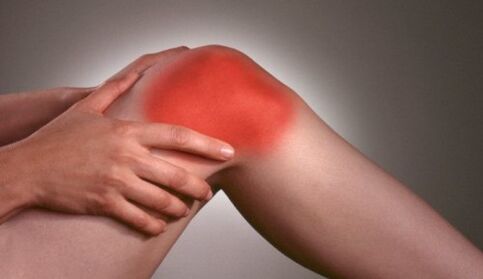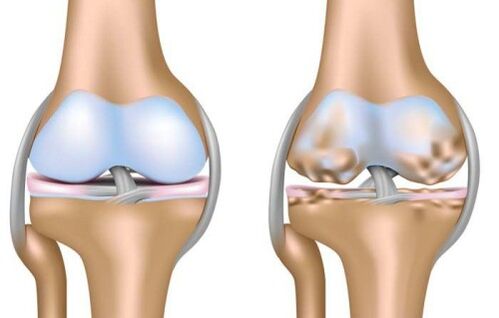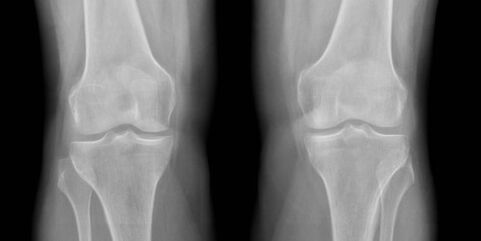Osteoarthritis of the knee joint (gonarthrosis) is a disease that causes deformation of the cartilage of the knee joint. This disease is very common, especially in the older generation. The work of the knee is deteriorating, so difficulties in its mobility and feeling of pain are the most important signs of the disease. Today, osteoarthritis of the knee joint is common in people aged 25-30. Which speaks to the variety of causes of the disease and, consequently, its treatment. >There are two types of gonarthrosis: unilateral (affecting only one knee) and bilateral (affecting both knees). The disease occurs more often in its bilateral manifestation.

Reasons
Gonarthrosis, like coxarthrosis, most often manifests in old age. Although today, the fact that young people have symptoms of this disease is no exception. This suggests that the causes of gonarthrosis are different and each in its own way can affect the onset, exacerbation and treatment of the disease. There are also possibilities of genetic predisposition of the organism, ie. Osteoarthritis of the knee joint may be more common in certain families than in others. In addition, this disease may not be genetically determined. Therefore, there are several causes of gonarthrosis.
- Various bodily injuries of the knee (bruising, sprain, etc. ).
- Large loads that do not correspond to age (5-7% of all cases of gonarthrosis, as well as coxarthrosis).
- Overweight patient (10% of all cases of gonarthrosis).
- Concomitant diseases, for example, arthritis (5-7% of all cases of gonarthrosis, polyarthrosis and coxarthrosis).
- Congenital ligament weakness (3-5% of gonarthrosis cases).
- Metabolic syndrome and metabolic problems in the body.
- Upper thigh muscle spasm (up to 50% of gonarthrosis and coxarthrosis).

Symptoms
The symptoms of osteoarthritis of the knee joint are mostly the same, and they occur in almost all patients. Patients also notice that the worsening of pain falls on the spring-autumn period and depends on weather changes. The main symptom of the disease is knee pain. It usually does not appear immediately, but is noticed only after a long walk and occurs in the late afternoon. The ringing can represent stiffness of the knee when moving. If minor symptoms are left unattended, then the disease can start and can bring extremely undesirable results for the patient. Despite the main symptoms, there are several other signs of the disease:
- resting pain syndrome, which qualitatively decreases when walking;
- limited movement of the knee joint and difficulty in controlling its mobility;
- knee stiffness;
- increased sensitivity in the knee area;
- swelling in the knee joint and swelling of the skin around;
- knee joint deformity.
Assessment of the condition of the knee joint is performed during a medical examination and X-ray. Moreover, the stage of the disease of any arthrosis (including coxarthrosis, gonarthrosis, polyarthrosis and others) can be determined only if there is an X-ray and only a doctor can make an assessment of such a condition. Therefore, it is extremely important not to engage in self-diagnosis and not to draw conclusions too quickly.
Degrees of gonarthrosis
1st degree
The knee joints have not succumbed to the deforming influence of the disease, but appear only by external signs and mild swelling of the periarticular skin, changes in its color are noticeable. At the physiological level, it is characterized by minor changes in hyaline cartilage. As a result of the accumulation of a significant amount of joint fluid in the synovium, minor deformities of the joints occur, which are accompanied by pain when walking. Other signs such as limited mobility are not noticed. And therefore they are difficult to trace on radiography. At this stage, the disease is difficult to diagnose, but with a quick definition, its treatment will be more effective than in the second or third degree of gonarthrosis, as well as other types of arthrosis (coxarthrosis, polyarthrosis).
II degree
The main symptom is unbearable or intense pain, even with a slight load, which is aggravated by walking and lifting weights. Over time, this will develop into difficulties with bending the knees. At the physiological level, this is manifested by the fact that the volume of the cartilage layer decreases sharply, and in some places it is completely absent. According to the results of X-rays, this degree can be determined according to the marginal bone growths and the density of the joint space. In the work of the joint, especially during a long walk, a characteristic crunch appears. Gradually, the patient may lose the ability to bend the knee, or it will be given to him with great difficulty. The deforming effect is already manifested in this phase of the development of gonarthrosis, as well as other types of arthrosis (coxarthrosis, polyarthrosis). It is visible visually, and the skin around becomes rough and changes color. Treatment at this stage is better to start complex and intensive. Both medicines and traditional methods of treatment will be relevant here.

III degree
It is characterized by severe pain, even when the knee joint is inactive or immobilized. The deforming effect is very noticeable and significant changes in the structure of the joint and adjacent tissues can be determined visually. At the physiological level, it is marked by the absence of cartilage tissue and it is easy to diagnose on an X-ray. Treatment of grade III knee osteoarthritis and other types of osteoarthritis (polyarthrosis, coxarthrosis) is actually an irreversible process. Instead, the main goal of such treatment will be to reduce pain and eliminate some symptoms of disease manifestation.


























